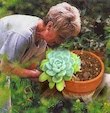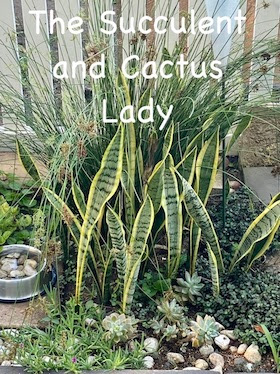About me

🌿 I've been gardening ever since a child, when I spent time with my father in his vegetable garden. But my fascination with Echeverias started in the 1980's, when my father gave me a pot with five Echeverias, which turned out to be E. imbricata. At first I wasn't much interested in them and planted them in some obscure corner of the garden and completely forgot about them. How great was my surprise when, a couple of months later, I noticed that they had spread and made a beautiful display - I was hooked!
Pages
Saturday 26 July 2014
Echinopsis - 6am in Winter
6am in my garden one Winter's morning (Tarlton, Gauteng, South Africa) and still dark outside. My small Cacti (Echinopsis oxygona) were in full flower and they had appeared over-night, seeming to lighten this area with their beautiful lilac/pink flowers, which have a sweet smell. My Barrel cactus in the background, native to the Southwest Desert of North America, is approximately 15 years old.
Echinopsis oxygona is native to South Brazil, Uruguay and northern Argentina. Its features include many robust spines, spherical shape, and a large flower, with sharply pointed lavender petals, and a fine faint scent.
Echinopsis Oxygona grow prosperousely in full sun, or light shade. These cacti can stand through strong heat, and even through temperatures as low as -10°C (14°F). Usually these are outdoor plants. These plants are used to the dry, desert climate, so they do not need to be watered every day.
Camera : FujiFinepix 2800Zoom Digital - flash enabled
.
Sunday 20 July 2014
Aloe ellenbeckii
Family: Aloaceae
Genus: Aloe (AL-oh)
Species: ellenbeckii (el-len-BEK-ee-eye)
These low-growing, drought-tolerant aloes grow in sun to partial shade and start flowering mid-Autumn to early-Winter. Aloe ellenbeckii is a widespread species in East Africa, but he population may be in slow gradual decline due to loss and degradation of it's habitat - natural areas in the region where Aloe ellenbeckii occurs are increasingly under pressure from agricultural expansion.
Aloe ellenbeckii grows in partial shelter of bushes in deciduous bushland on limestone. Small plants are clumped together, and clumps are scattered. The plants have fleshy thick leaves of beige and light-green with rows of lighter toned dots that are placed up and down each leaf. The Aloe ellenbeckii produces beautiful white teeth on its leaves, with a variegated spot look. The new plants produced by the Aloe ellenbeckii spread loosely across the landscape into large colonies.
.
Thursday 17 July 2014
Peanut cactus (E. chamaecereus)
The common name of 'Peanut cactus' comes from the peanut-like offsets that this cactus provides generously along the stems. These offsets can be detached and planted immediately.
Echinopsis chamaecereus is a small clumping cactus, about 4 inches (10 cm) high. If the stems become longer than this, they tend to lay down on the ground or hang from the pot – grown in more shade than it prefers Peanut Cactus will sprawl and hang quite nicely over the edges of a pot. They therefore look great in hanging baskets. But don't water this cactus too much - it causes the mother plant to rot away, leaving the offsets stranded or falling off if they're hanging over the edge - rather err on the side of giving too little water.
The Peanut cactus grows well in the shade, but tends to form long, hanging ropes, which are easily controlled by just cutting them off and planting them again.
The beautiful flower of the Peanut cactus.
In full sun, the Peanut cactus tends to be more clumpy, but I have two that are in full sun that have still sent out long, hanging ropes. If your cactus is used to shade, introduce it to sunlight gradually as they easily get burnt.
.
Sunday 13 July 2014
Aeonium
Aeonium are without a doubt, some of the most beautiful and sought after additions to succulent collections. They reward our efforts with gorgeous spoon shaped foliage in shades of burgundy and green, sometimes variegated with splashes of palest gold.
In winter I do not remove the dead bottom leaves as they provide protection against the cold
.Aeonium are native to the Canary Islands and North Africa, so you may be able to guess their preferred conditions - warm, or even hot would be the key word.
.
The name means 'evergreen' so this is a plant that never loses its leaves – until after it blooms that is, when the flowering rosette dies. But by then you should have lots of pups to keep this plant going.
Aeonium grow best where minimum temperatures are about 4 degrees Celsius; they can’t take any frost, so a sheltered or indoors environment only for this plant. It requires good ventilation, and bright light – full sun is fine, or partial shade. They prefer a little more moisture in the soil than many other succulent plants. Water as soon as the soil is dry, but don’t allow it to dry too much.
Aeonium in the pot at the back and to the right, in front is Echeveria glauca, which shows the difference between these two species
.Some Aeonium will form a fairly tall stand of rosettes of green, dark burgundy or variegated foliage each on the top of a slender stalk. The leaves are spoon-shaped, sometimes glossy, and occasionally matte.
They can reach a height of a meter (3'), or less than 15cm (5"), depending on the variety. Other species and varieties are suitable for mixed planters and succulent crafts as they tend to be more compact.
Easy to propagate, just remove a rosette with a piece of stem and allow to callous overnight and the stem end can be planted into a pot.
Aeonium - the lovely pink tinges that emerge in winter
Burgundy-tipped Aeonium sharing a pot with an Aloe, some Crassula and a cactus
Aeoniums are members of the Crassulaceae, a huge family of succulents
that include many other popular and commonly grown succulents, including
some that look a lot like Aeoniums. Echeverias in
particular are often confused with Aeoniums and there are several other
rosette-like succulents (eg. Dudleyas, Graptopetalums, Pachyverias and
Graptoverias). One thing that sets t these plants apart is
the way their leaves attach to the stem - they are wrapped around the
stem with a fibrous attachment so that when a leaf is pulled away, the
stem is intact with only a transverse line showing where the leaf was
attached. The other rosette Crassulaceas have succulent attachments and their being pulled off the stem leaves a divot in the stem.
.
Wednesday 9 July 2014
Winterizing succulents
Every Autumn I get most of my succulents ready to come indoors by gradually decreasing the amount of water they receive and as it gets colder, when temperatures reach about 5℃, I bring them inside. Even though both the Crassula and Aeoniums in this pot can withstand a fair amount of cold, I’d hate to lose them, so rather safe than sorry!
Crassula imperialis (the spidery one on the left) prefer very porous soil, and it is preferable to drench them well and allow the soil to dry somewhat between waterings. They enjoy cool summer conditions, good light, and good air circulation. High heat in the summer, when they are dormant, will often cause lower leaves (those tiny little dots are leaves!) to drop. Crassula need winter warmth and will sit and sulk if kept damp and cold. Crassula is easily propagated by just breaking off a piece and sticking it into the soil and before long you will be rewarded by a lovely, spreading little plant.
Aeonium (tree houseleek – (on the right) is a genus of about 35 species of succulent, subtropical plants of the family Crassulaceae. The name comes from the ancient Greek “aionos” (ageless). While most of them are native to the Canary Islands, some are found in Madeira, Morocco, and in East Africa (for example in the Semien Mountains of Ethiopia).
The rosette leaves are on a basal stem. Low-growing Aeonium species are A. tabuliforme and A. smithii; large species include A. arboreum, A. valverdense and A. holochrysum.
Aeonium are not frost-resistant. They are related to the genera Sempervivum, Aichryson and Monanthes, which is easy to see from their similar flower and inflorescences. Recently, the genus Greenovia has been placed within Aeonium.
These Aeoniums in a pot spend the summer outside and then also come inside for the winter
::
.
Subscribe to:
Posts (Atom)







.JPG)















